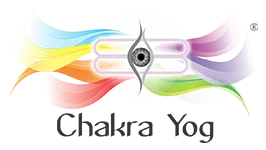Yoga Asanas for Muladhara Chakra
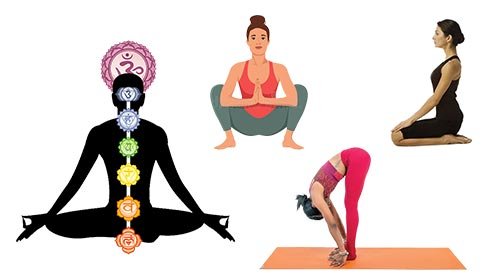
The life force energy (known as “prana”) passes through the subtle body through a number of channels known as “nadis” in yoga. These nadis meet at areas of amplified energy known as “chakras.” Chakras are swirling vortexes of energy in the subtle body that correlate to specific glands along the spine and within the head. They are named after the Sanskrit word for “wheel.” When the nadis get blocked due to bad behaviors and old patterns, the chakras become stagnant. The life force becomes sluggish as a result, which may lead to reduced physical, mental, and emotional health. Yoga practice cleanses and revitalizes the nadis and chakras, allowing prana to flow freely again.
Yoga is an incredibly useful method for releasing prana, or life energy, when it becomes wedged. Through yoga poses (asanas) and breathing, yoga dissolves musty energy and allows new energy into our chakra system. As a means of rebalancing our chakras so that they work optimally we may practice yoga as it definitely helps to either activate a blocked chakra or discharge excess energy from a dysfunctional chakra, for example when a chakra becomes overactive.
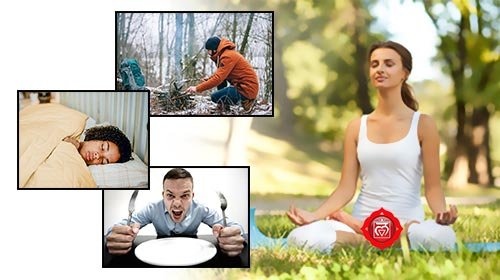
An effective way to bring to balance the Root (Muladhara) Chakra is to resort to yoga asanas practice on a regular basis, which stabilizes and balances your physical body’s foundation from the root. Makes it simpler to break old habits and patterns by realigning Muladhara, which govern instinctive behavior patterns. At the base of our vertical axis (the spine), this chakra is responsible for our fundamental instincts like survival, hunger, sleep, sex and self-preservation. The pelvis and the legs are the primary targets of yoga practice in order to develop and strengthen our root chakra’s vital energies.
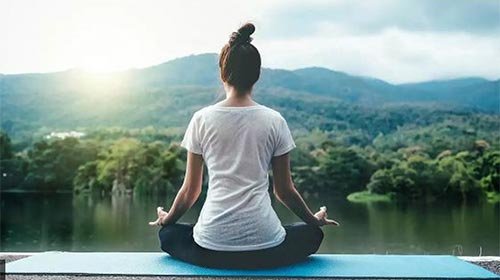
Yoga can be practiced at home, in natural environments or in a yoga studio. At the same time, each chakra is connected with different universal elements being Air, Earth, Water, Ether or Fire. While yoga asanas may be practiced with beneficial results in many distinct surroundings, it is recommended whenever is possible to do these in particular places related to the chakra’s element to enhance the whole experience and results. In the case of Muladhara as it is connected with our grounding Earth element, yoga practiced outdoors in direct contact with Nature is the first choice to heighten the healing experience of the practice. When this is not doable to perform, we can equally get beneficial results by practicing it at our home, yoga studio or other specifically dedicated space for this practice too.
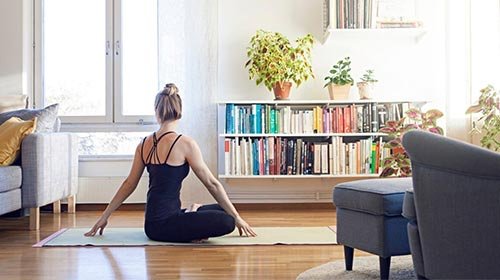
Creating a home yoga studio has several advantages and may take your yoga practice to a whole new and enhanced level. It helps you to immerse yourself in yoga so that it becomes a more important part of your everyday rather than something that is exclusively performed at a studio. Indeed, yoga experts and teachers acclaim contrary to popular belief to practice yoga at your own pace in your own place rather than in busy and distracting public yoga centers which tend to rush the practice in too active modes and with limited time and procedures. They reiterate that the practice of yoga should be paced at each person’s rhythm thus allowing a much better integration of the practice as it involves aspects like focus, absorption, breathing or meditation. Therefore, getting involved in public spaces with yoga experienced teachers is principally suggested mostly to get started with the right postures under their supervision at first, but more personal places and environments are more suitable for yoga practice for the healing and balancing of our energy centers (chakras) in the long-term.
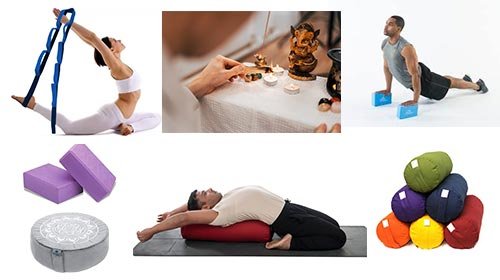
Even in the tiniest of areas, you can carve out a nook and corner for your home yoga studio. The first item you’ll need is a yoga mat, or if you can’t find one, a towel will do. It will protect you from slipping and sliding while you practice yoga.
Below are some other items you may need in your daily yoga practice:
- Yoga Bolsters are used to aid in relaxing, softening postures, and opening up the body. As an alternative, you may make an improvised bolster out of a pillow covered in a blanket. It forms an oval and may be used as a bolster to rest against.
- Yoga Blocks are used to aid in the practice of yoga by bringing the floor closer to you if you are unable to reach it in certain poses. If you don’t have access to yoga blocks, you may use thick books.
- Yoga Straps are used to assist yoga practitioners in achieving a greater range of motion and increased flexibility. Likewise, resistance bands may also be used as an alternative.
- Yoga blankets are great to have on hand since they can help you sit comfortably and relax in restorative positions. As an alternative to yoga-specific blankets, you may use blankets from your bed, throw blankets from your sofa, or towels.
- Yoga cushions and chairs aids in meditation and they are utilized to keep the body in a comfortable sitting posture. They tilt the pelvis, allowing you to sit erect and securely in meditation position. If they are not accessible, you may sit on any cushion from your home, such as one from your sofa or bed, while meditation.
- Altars and the things that decorate them are utilized to integrate the energy of your yoga practice into your surroundings. Deities’ sculptures and sacred symbols and pictures are often placed.
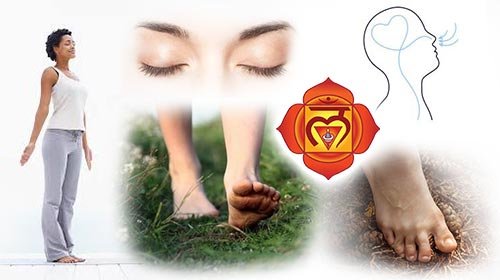
As you work with this chakra, build a sensation of earthiness, radiance, and stability in your feet, legs, and pelvic floor via asana, breath, and meditation. Aim to feel radiant rather than hurried, and steady rather than stuck.
To connect with Muladhara energy, one of the simplest methods is to stand tall, shut your eyes, and feel your feet contacting the earth. Consider filling your feet, legs, and pelvic bowl with live healthy soil. Sensitize yourself to the stability it imparts to your body and breath.
Try stomping to kick it up a notch. Remind yourself that you belong to this place. You have chosen to be here. You have a right to be in this body, in this life, and a sacred obligation to stand up with purpose.
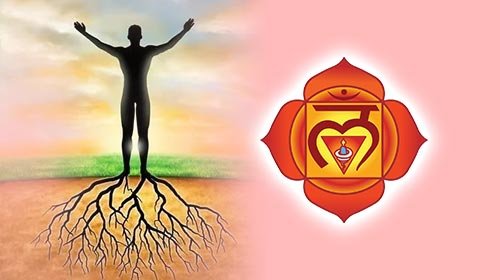
Muladhara (“root support”), the foundation chakra encompassing the tip of the tailbone and the pelvic floor, is linked to our fundamental stability in life and relationships. When we have a balanced Muladhara chakra, we feel stable no matter what life throws at us and “at home” wherever we go.
A complete yoga sequence must include a series of active poses followed by a series of restorative asanas to round up the practice and get the most of it.
Muladhara (“root support”), the foundation chakra encompassing the tip of the tailbone and the pelvic floor, is linked to our fundamental stability in life and relationships. When we have a balanced Muladhara chakra, we feel stable no matter what life throws at us and “at home” wherever we go.
A complete yoga sequence must include a series of active poses followed by a series of restorative asanas to round up the practice and get the most of it.
Below are a sequence of active yoga poses for Muladhara:
SUPPORTED CHILD’S POSE
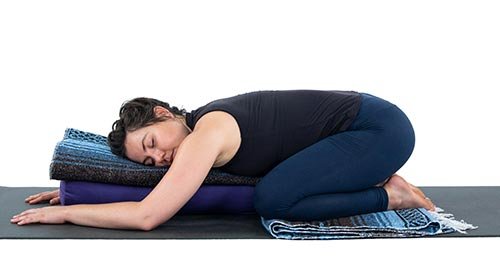
To be ready for supported child’s pose, make a “bolster ramp” a few feet away from the wall by raising the section of the bolster farthest away from the wall with a block on its flattest, widest setting. Place an eye cushion or tiny towel at the bolster ramp’s apex. Roll one blanket halfway to the center, then sit on your heels, knees on each side of the bolster ramp, the thin blanket roll at the hip crease at the top of the thighs to assist sink the hips further into their socket homes. Fold forward over the bolster, using the eye pillow to support your forehead so that your nose does not push into the bolster. Place your hands, palms flat, on each side of the bolster. If you have extra blankets, you may place them under your hands or feet. The Supported Child’s Pose feels like a warm, nurturing embrace across your belly and chest, with a quiet release in your lower back and hips. You will feel comfortable and grounded in this position because your tummy and chest are shielded and supported, and your knees are drawn in towards you.
Muladhara is related to earth, and in this posture, you are laying your hands on the ground, as if checking to see whether it is there. As if to ensure that it will hold you. Attune to the true presence of the Earth underneath you: this substantial, lumbering globe plodding through space. It has the ability to hold you; it has been holding you all along. You may put your weight on it and get heavy on it. Are you resisting or clutching anyplace, or are you attempting to support yourself in some way? Allow the Earth the task of sustaining you.
REVERSE CHILD’S POSE
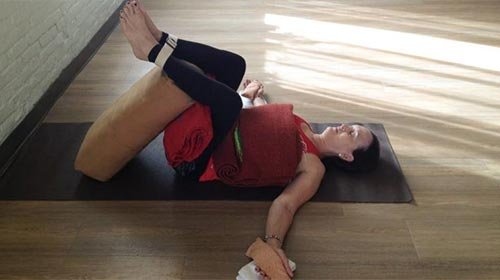
One of your blankets should be rolled halfway to the middle, and the other should be folded in a long rectangle. Tie the strap around your ankles loosely. Lie on your back with the little blanket roll slightly behind the frontal hip bones and the unrolled blanket draped over your tummy and chest. Draw your knees in near your chest and lay the blanket folded into a wide rectangle on the back sides of your thighs, right under your knees. Slant the bolster from the mat to the blanket below your knees so that its soft weight draws your knees closer to your chest. Rest your calves on the bolster and gently separate your knees. Place your arms in a position that is comfortable for you.
SUPPORTED STRETCH OF THE WEST AT WALL
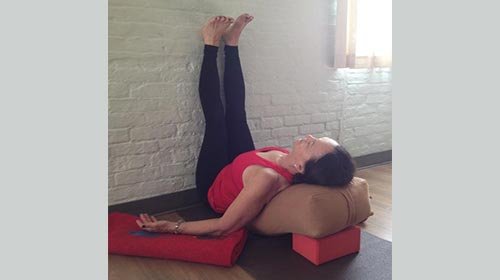
Sit at the bolster ramp around a foot away from the wall, with one of your hips flat against the wall, for a grounding forward fold wherein the spine is both long and supported. Swing your legs up the wall and relax along the bolster’s length. Allow your hips to be heavy on the floor while the bolster supports you up from the lower back to the back of your head. If the bolster is too much of a stretch for your hamstrings or across your chest, do legs-up-the-wall with your back on the mat, tipping the tailbone back into the mat to preserve your lumbar curve. Bring the bolster up higher for a deeper stretch, try placing two blocks beneath it, one in the center, on the lowest level, and one below your head, on the tallest setting. Sit at the bottom of a bolster ramp around a foot away from the wall, with one of your hips flat against the wall, for a grounding forward fold wherein the spine is both long and supported. Swing your legs up the wall and relax along the bolster’s length. Allow your hips to be heavy on the floor while the bolster supports you up from the lower back to the back of your head. If the bolster is too much of a stretch for your hamstrings or across your chest, do legs-up-the-wall with your back on the mat, tipping the buttocks back into the mat to preserve your lumbar curve. Bring the bolster up higher for a deeper stretch and try placing two blocks beneath it, one in the center, on the lowest level, and one below your head, on the tallest setting.
SUPPORTED WIDE-ANGLE POSE AT WALL
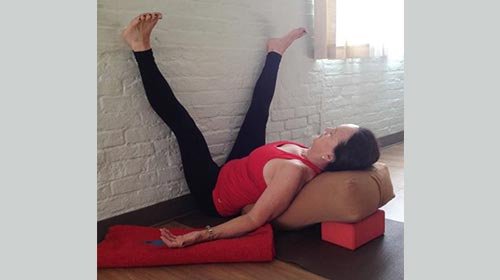
Follow the directions for supported stretch of the west at wall as in the previous yoga asana, then widen your legs away from each other.
SUPINE SUPPORTED BOUND ANGLE POSE
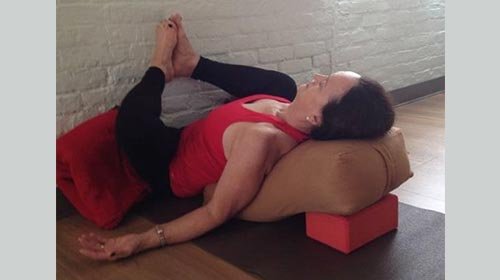
Follow the directions for the reclining supported stretch of the west above, then bend your knees, bring your feet together, and broaden your knees apart from each other, putting blankets or upright bolsters under the knees if you have any knee or hip stiffness.
SAVASANA AT WALL

Bend the knees, plant the feet in front of the bolster, raise the hips up, and slide the bolster out from beneath you to exit supported bridge and into savasana at the wall. Return to your original position, resting flat on the floor with your feet against the wall, and straighten your tied legs. Consider how it feels to have the wall beneath your feet in a stance where they are not normally supported.
Muladhara’s mantra is LAM. You may repeat this sound to yourself while on this pose; Can you feel its reverberations in the pelvic floor and the tip of your tailbone even if you don’t utter it aloud? After intentionally repeating this sound, you may notice that it appears to continue on its own, like a stone you gently pushed, a stone that is now rolling all by itself. You might envision the sound LAM rolling up your spine, eliminating any impediments to the upward flow of energy.
Final Considerations for Yoga Balancing of Muladhara
Aside from the yoga positions outlined above, cultivating a deeper feeling of steadiness throughout your practice may take various forms. If visualizations have previously benefited you in your practice, consider imagining or wearing the color red, which is the color of the Root (Muladhara) Chakra. This vision may assist you in reconnecting with your inner feeling of groundedness and revealing a stronger connection while practicing the above yoga asanas. Singing mantras or using sound vibrations in the background is another excellent approach to connect with your Root (Muladhara) Chakra while doing yoga.


